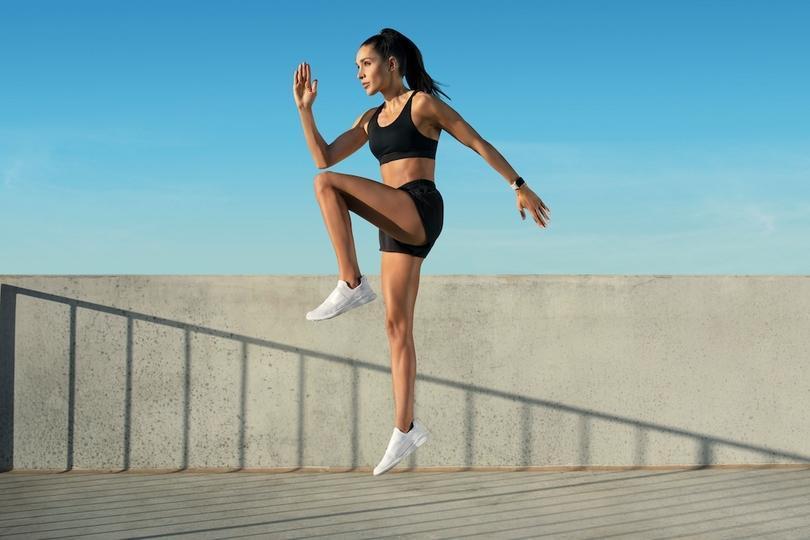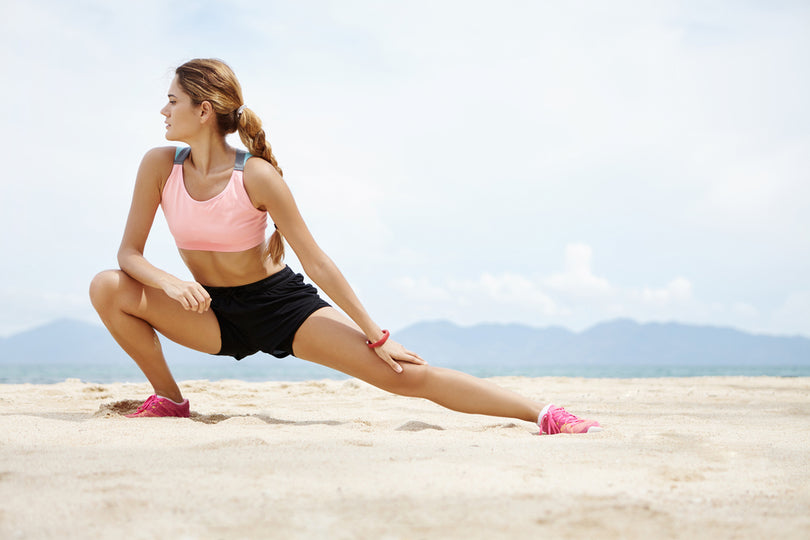5 Ways To Step Up Your Squats


You might love them or you might loathe them, but there’s no denying squats are one exercise you probably keep coming back to!
Squats are a compound exercise that train the muscles in your lower body — your quads, glutes and calves — and you should also be engaging your core when you perform squats or variations. They can be done using just bodyweight for resistance, which means you can do them anywhere. You’ll find squats or a variation in my High Intensity Zero Equipment with Kayla Itsines (formerly BBG Zero Equipment) workouts as they are a really effective exercise you can do without any kind of gym equipment.
You can add in a bit of a challenge with squats too if you want to step up your training — here are a few squat variations for you!
Try these variations to take your squats to the next level
If you’re ready to get even more out of your workout, then step up your squats with these variations:
Sumo squats
With your feet planted slightly further apart than a standard squat, you’ll be helping to work both your inner thighs and exercise your glutes.
1. Plant both feet on the floor further than shoulder-width apart. Point both feet slightly outward. This is your starting position.
2. Looking straight ahead, bend at both the hips and knees, ensuring that your knees point toward your toes.
3. Continue bending your knees until your upper legs are parallel with the floor, ensuring that your back remains between a 45 to 90-degree angle to your hips.
4. Push through your heels and extend your legs to return to the starting position.
Double-pulse squat
By adding a pulse to your squat, you force your muscles to contract for longer. It targets those lower body muscle groups, like your glutes, quads and calves while also needing your core to remain tense.
1. Plant both feet on the floor slightly further than shoulder-width apart.
2. Looking straight ahead, bend at both the hips and knees, ensuring that your knees point towards your toes.
3. Continue bending your knees until your upper legs are parallel with the floor. Ensure that your back remains between a 45 to 90-degree angle to your hips. This is called full squat position.
4. Push through your heels to extend your legs slightly. Bend your knees to return to full squat position. Complete this action, called a pulse, two times.
5. Push through your heels and extend your legs to return to the standing position.

Single-leg squat
If you’ve tried my plank variations, you might be familiar with a leg raise already! Single-leg squats are a great way to test your balance and by isolating each leg, you may be able to help even out any muscular imbalances. They take a little bit of practice, but keep at it!
1. Plant both feet on the floor slightly further than shoulder-width apart.
2. Elevate your left leg and bend your knee slightly to lift your foot off the ground. Hold your elevated foot in front or behind you, depending on what feels the most comfortable. This is your starting position.
3. Looking straight ahead, bend your hips and right knee to lower yourself down as far as is comfortable, ensuring that your back remains between a 45 to 90-degree angle to your hips.
4. Push through your heel and extend your leg to return to the starting position. Try to keep your left foot elevated off the ground throughout each rep.
Single-leg squats are quite a tough exercise to master, so one way to help work up to these is to practice sitting down onto a bench or chair first!
Goblet squat with kettlebell
For this squat variation, you’ll need a kettlebell. If you don't have a kettlebell, you could use a single dumbbell or a heavy household object, such as a milk bottle filled with sand. By adding some extra weight, your core, glutes and your balance get an extra challenge.
1. Holding a kettlebell with both hands directly in front of your chest, plant both feet on the floor slightly further than shoulder-width apart. This is your starting position.
2. Inhale. Looking straight ahead, bend at both the hips and knees, ensuring that your knees point toward your toes.
3. Continue bending your knees until your upper legs are parallel with the floor, ensuring that your back remains between a 45 to 90-degree angle to your hips.
4. Push through your heels and extend your legs to return to the starting position.
Jump squat
Jump squats add an element of explosiveness to your workout! This plyometric variation not only works your muscles, but it also adds some cardio to your routine.
1. Plant both feet on the floor slightly further than shoulder-width apart.
2. Looking straight ahead, bend at both the hips and knees, ensuring that your knees point towards your toes.
3. Continue bending your knees until your upper legs are parallel with the floor. Ensure that your back remains between a 45 to 90-degree angle to your hips. This is called squat position.
4. Propel your body upwards into the air. Extend both your legs and your hips before landing back into squat position.
When landing, ensure that you maintain “soft” knees to prevent injury.
As always, keep an eye on your technique! Don’t let your knees extend too far over your toes as you squat down and try to keep your back straight. Give your form a quick check in the mirror to make sure you’re doing it correctly.
Step up your squats by challenging yourself!
If you want to see even more improvement in your squats, try these glute activation exercises before your next workout!
Are you feeling inspired to challenge yourself with some new ways of squatting? Or do you want to see some other exercise modifications? Comment with your ideas below!
* Disclaimer: This blog post is not intended to replace the advice of a medical professional. The above information should not be used to diagnose, treat, or prevent any disease or medical condition. Please consult your doctor before making any changes to your diet, sleep methods, daily activity, or fitness routine. Sweat assumes no responsibility for any personal injury or damage sustained by any recommendations, opinions, or advice given in this article.




<#= c.user.username #><#= moment(c.created_at * 1000).fromNow() #>
<#= c.html_body #> <# if (c.images) { #>
<# } #>